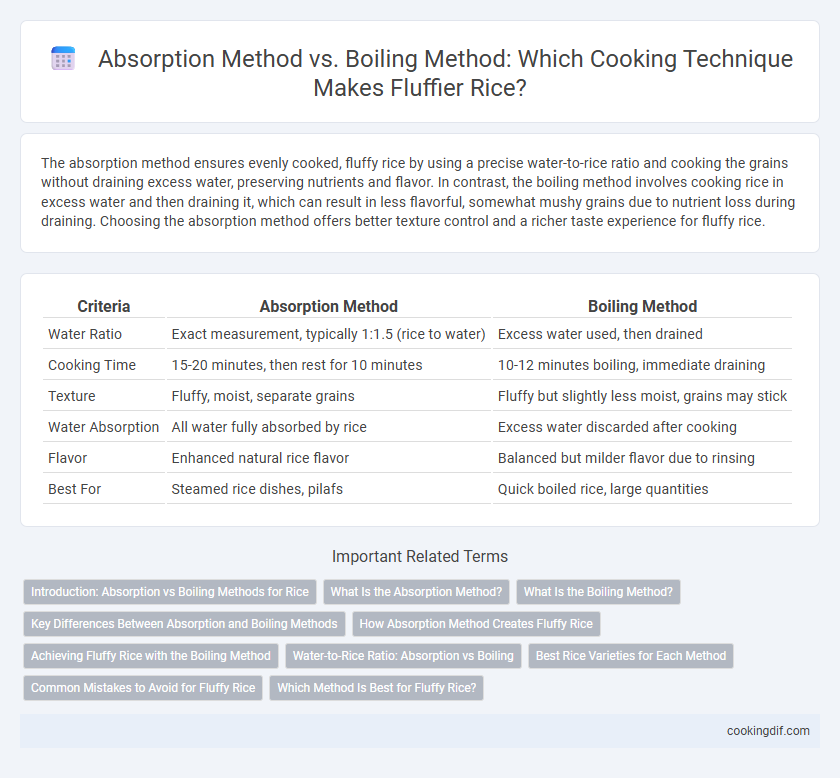The absorption method ensures evenly cooked, fluffy rice by using a precise water-to-rice ratio and cooking the grains without draining excess water, preserving nutrients and flavor. In contrast, the boiling method involves cooking rice in excess water and then draining it, which can result in less flavorful, somewhat mushy grains due to nutrient loss during draining. Choosing the absorption method offers better texture control and a richer taste experience for fluffy rice.
Table of Comparison
| Criteria | Absorption Method | Boiling Method |
|---|---|---|
| Water Ratio | Exact measurement, typically 1:1.5 (rice to water) | Excess water used, then drained |
| Cooking Time | 15-20 minutes, then rest for 10 minutes | 10-12 minutes boiling, immediate draining |
| Texture | Fluffy, moist, separate grains | Fluffy but slightly less moist, grains may stick |
| Water Absorption | All water fully absorbed by rice | Excess water discarded after cooking |
| Flavor | Enhanced natural rice flavor | Balanced but milder flavor due to rinsing |
| Best For | Steamed rice dishes, pilafs | Quick boiled rice, large quantities |
Introduction: Absorption vs Boiling Methods for Rice
The absorption method involves cooking rice with a precise amount of water, which allows the grains to absorb moisture evenly, resulting in a fluffy and tender texture. In contrast, the boiling method requires cooking rice in excess water and draining the surplus, which can sometimes lead to nutrient loss and less controlled texture. Choosing between these methods impacts the rice's consistency, flavor retention, and nutritional value.
What Is the Absorption Method?
The absorption method involves cooking rice by adding a precise amount of water that the rice completely absorbs during the cooking process, resulting in fluffy, separate grains. This technique requires careful measurement of water to rice ratio, typically 1.5 to 2 cups of water per cup of rice, and simmering with a covered lid to prevent steam from escaping. Unlike the boiling method, which involves draining excess water, the absorption method ensures maximum nutrient retention and a consistent texture.
What Is the Boiling Method?
The boiling method for cooking rice involves submerging rice in a large amount of boiling water until it is tender, then draining off the excess water, similar to cooking pasta. This method prevents rice grains from sticking together, resulting in a fluffier texture compared to absorption cooking. It is especially effective for long-grain varieties like basmati or jasmine, as the excess water removes surface starch and enhances fluffiness.
Key Differences Between Absorption and Boiling Methods
The absorption method cooks rice by simmering it in a measured amount of water until fully absorbed, resulting in fluffy, tender grains with minimal nutrient loss. In contrast, the boiling method involves cooking rice in excess water and draining the surplus, which can lead to nutrient dilution but allows greater control over texture. Key differences include water-to-rice ratios, nutrient retention, and the level of starch gelatinization affecting rice fluffiness.
How Absorption Method Creates Fluffy Rice
The absorption method creates fluffy rice by allowing grains to soak up a precise amount of water, ensuring even moisture distribution without excess liquid. This controlled water absorption prevents clumping and preserves the rice's natural texture, resulting in separate, tender grains. Unlike the boiling method, where excess water can cause stickiness or mushiness, the absorption technique delivers consistent fluffiness through gradual steam cooking.
Achieving Fluffy Rice with the Boiling Method
The boiling method achieves fluffy rice by cooking grains in excess water and draining the surplus after cooking, preventing over-starchiness and clumping common in the absorption method. Maintaining a rapid boil and promptly draining ensures individual, separated grains with ideal texture and moisture. This technique is favored for long-grain varieties like Basmati or Jasmine, enhancing fluffiness and lightness compared to the absorption method.
Water-to-Rice Ratio: Absorption vs Boiling
The absorption method uses a precise water-to-rice ratio, typically 1.5 to 2 cups of water per cup of rice, allowing the rice to absorb all the water without excess liquid, resulting in fluffy, evenly cooked grains. In contrast, the boiling method uses a larger volume of water, similar to pasta cooking, where rice is boiled in excess water and then drained, which can lead to less control over texture and potential nutrient loss. Optimal fluffiness is often achieved by the absorption method due to controlled water absorption and minimal starch leaching.
Best Rice Varieties for Each Method
Long-grain rice varieties like Basmati and Jasmine are ideal for the absorption method due to their firm texture and ability to retain aroma and flavor during water absorption. Medium and short-grain rice, such as Calrose or Arborio, perform better with the boiling method because their higher starch content creates a stickier, creamier consistency. Selecting the appropriate rice variety maximizes texture and taste based on the chosen cooking technique for fluffy, perfectly cooked rice.
Common Mistakes to Avoid for Fluffy Rice
Common mistakes to avoid for fluffy rice include using too much water in the boiling method, which results in soggy grains, and not allowing the rice to rest after cooking in the absorption method, leading to uneven texture. Stiring rice excessively during cooking can break the grains and cause clumping. Measuring water accurately according to rice type and cooking method is essential to achieve perfectly fluffy rice.
Which Method Is Best for Fluffy Rice?
The absorption method is widely regarded as the best technique for achieving fluffy rice due to its precise water-to-rice ratio and controlled cooking environment that prevents excess moisture evaporation. In contrast, the boiling method often results in less fluffy rice because excess water can wash away starches and nutrients, leading to a stickier texture. For consistently fluffy rice, the absorption method ensures even water absorption and ideal grain separation.
Absorption method vs boiling method for fluffy rice Infographic

 cookingdif.com
cookingdif.com